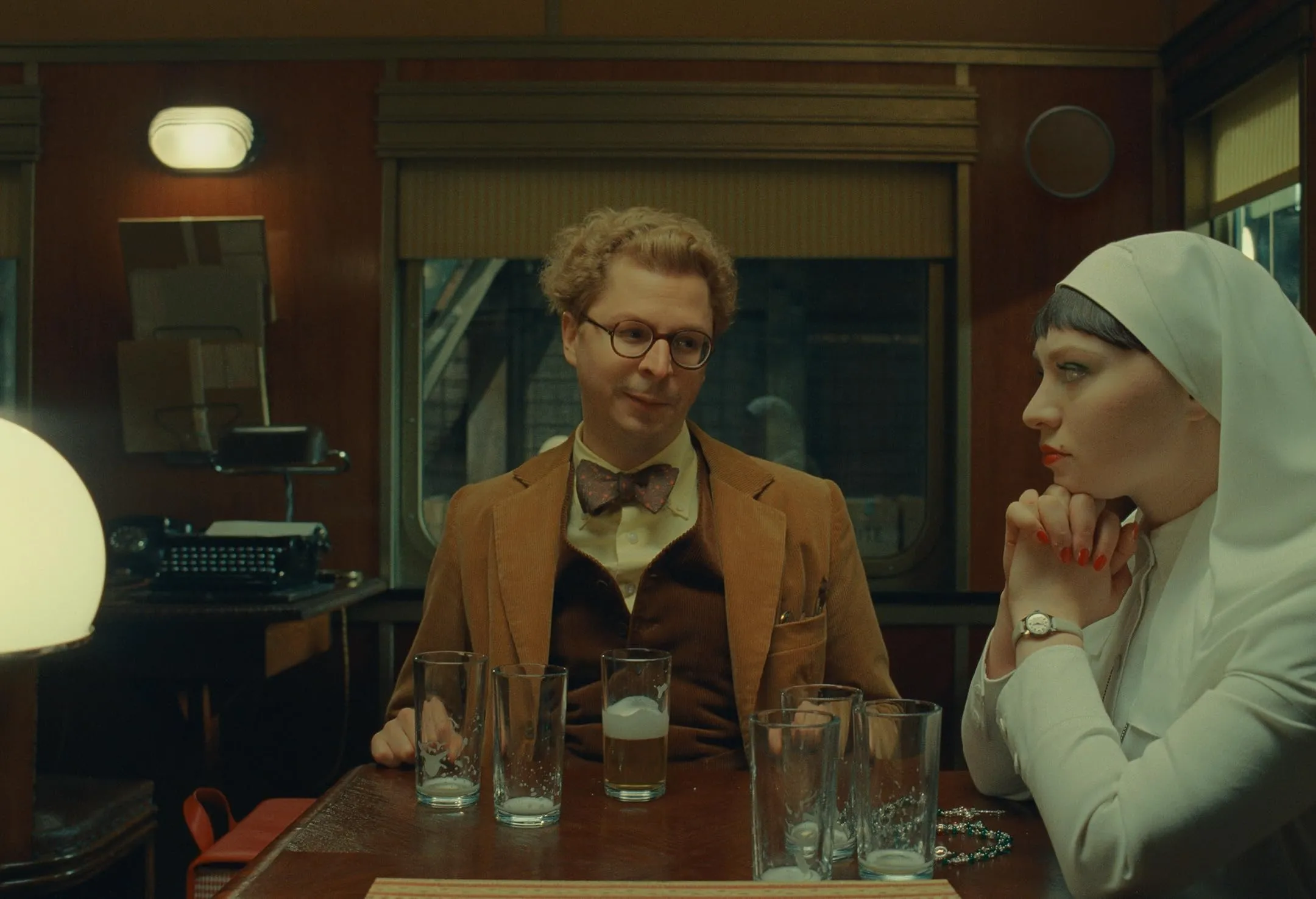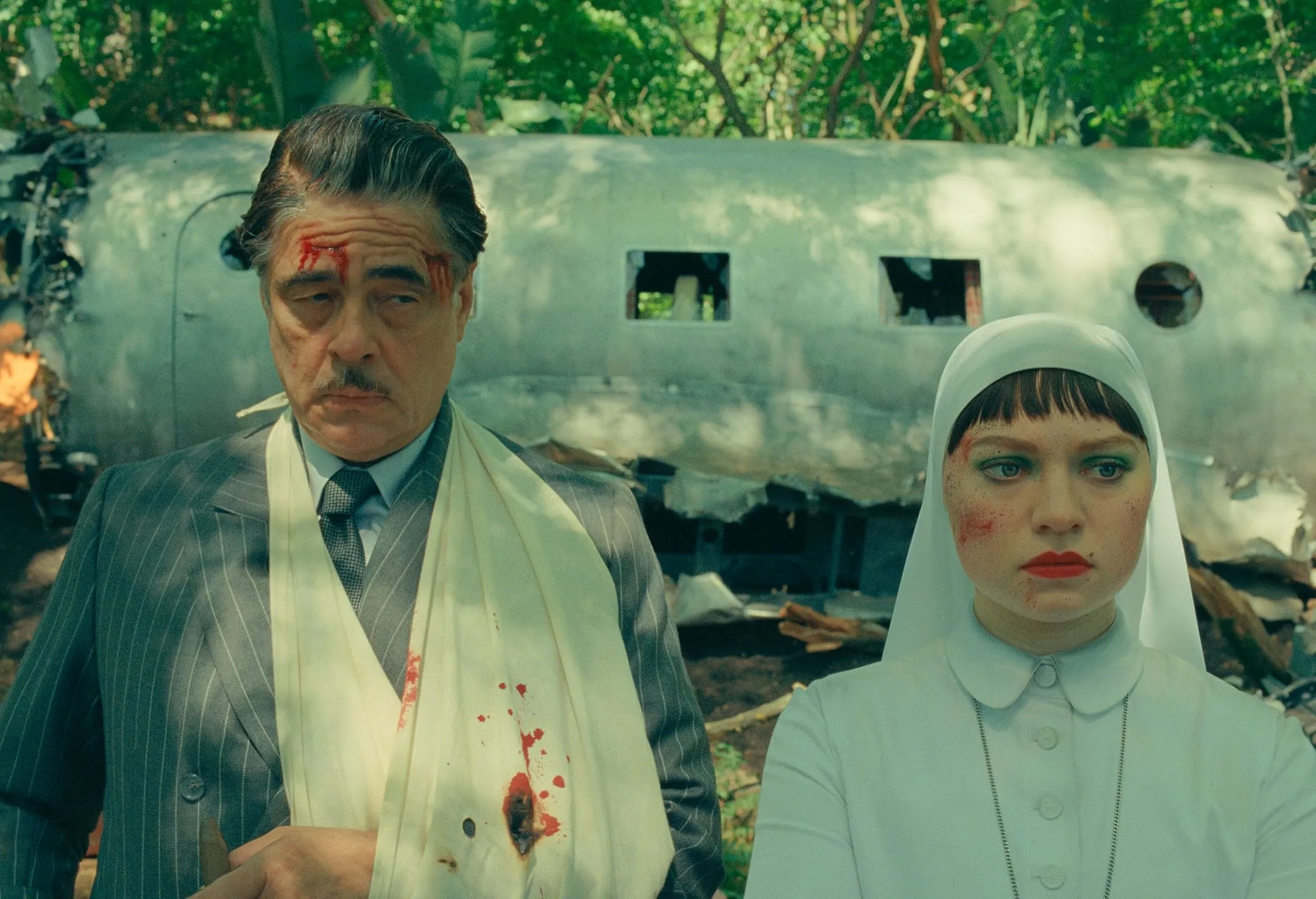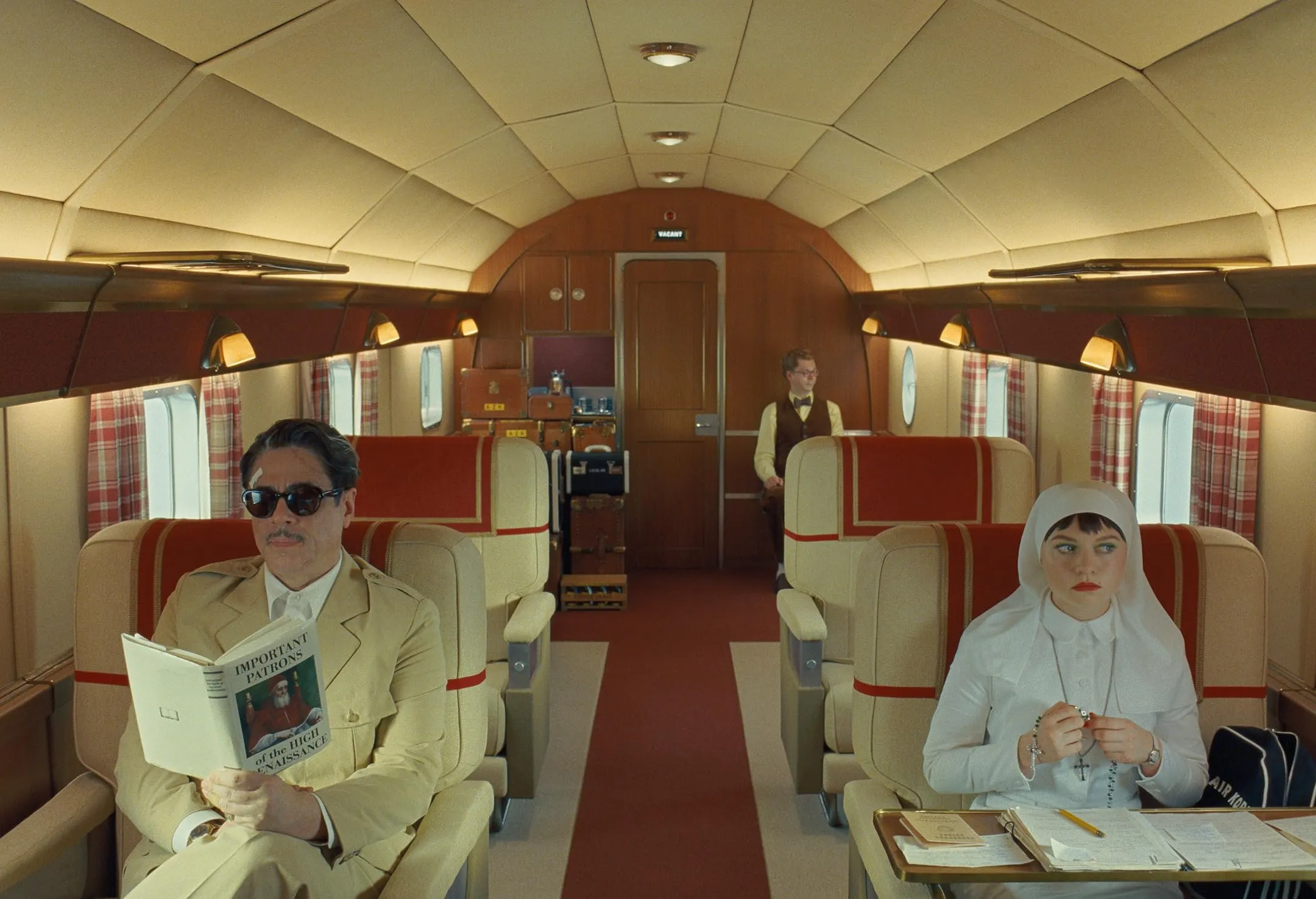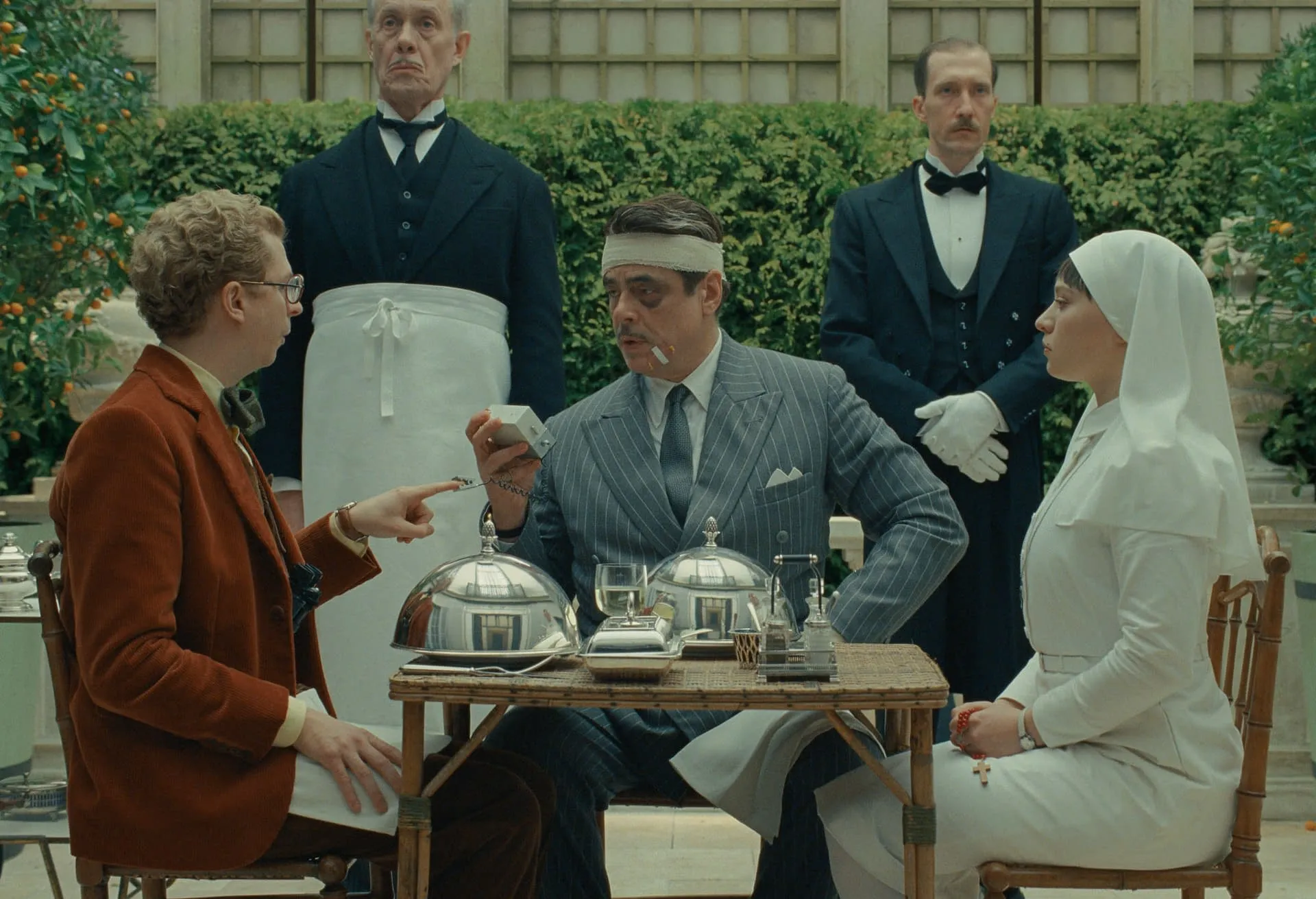A shattered fuselage lies half-buried in a windblown wheat field—metal bent into anguished curves, fragments of glass glinting like lost memories. From this violent epilogue of a private jet’s demise, Zsa-ssa Korda emerges, dusted in white-collar defiance, already scheming his next empire. In 1950’s Phoenicia, a land as fictional as the moral compass of its foreign exploiters, Korda strides ahead with bullets in his wake and ambition in his veins.
Here is a man who thinks himself immortal—until mortality, black-and-white and spectral, beckons him into fevered visions of judgment. He is a European industrialist with a ledger for a heart, determined to construct tunnels, waterways, dams: landmarks of legacy or monuments to hubris. Into this calculus enters Liesl, a postulant nun whose quiet faith fractures his equations. Their uneasy alliance becomes the story’s hidden axis: father and daughter circling one another, each seeking solidity in a world undone.
Wes Anderson’s style grants us a comedy-thriller painted in sepia tones—deadpan witticisms echo through cavernous ballrooms, and political satire hides behind symmetrical frames. Yet even as the film smiles, it probes darker questions: Can a man who traffics in profiteering ever confront his own frailty? And can familial bonds, threaded through betrayal and redemption, withstand the machinery of power? This section will examine how The Phoenician Scheme balances operatic spectacle with intimate existential stakes—its humor as sharp as any confession.
Architecture of Ambition and Abyss
The film opens in mid-air rupture: a private jet sheared by an unseen bullet, Korda tumbling through fragmented windows into a field of dust and disbelief. This assassination attempt is no mere spectacle—it is the first scar upon his invulnerable skin, the moment when hubris meets gravity. Emotion ripples through that crash site: a man accustomed to commanding railroads and rivers now lies flattened by chance and malice, wonder and dread mingling in his chest like contraband.
From this violent prologue unfolds the Phoenician Scheme itself—a triad of infrastructural dreams: a mountain-boring tunnel, a desert-spanning waterway, a basin-damming embankment. Each project, in its geometric precision, conceals the jagged fault lines of exploitation: slave labor, famine-wracked fields, and the alchemy of inflated “bashable rivet” costs that turn commerce into arithmetic cruelty. The financing gap yawns wide, a void into which Korda must pour persuasion as if it were liquid gold.
His pilgrimage across Phoenicia divides into six orchestrated encounters, each a movement in a grand caper symphony. On a dust-choked basketball court, he and his daughter face Leland and Reagan’s conditional yield—profit for prowess, contracts for competition. At Marseille Bob’s nightclub, neon shadows spool around them as coarse laughter greets their bargain.
On a creaking freighter, Marty’s handshake tastes of salt and suspicion. The half-constructed dam where Cousin Hilda towers is a monument both to ambition and to the brittle promise of water. A regal game of courtship with Prince Farouk becomes both ritual and ransom, hoops echoing doom. And at the desert palace finale, sun-bleached columns witness the ultimate wager.
Midway through, monochrome visions drag Korda into a liminal tribunal—heaven rendered in uneasy grain—compelling him to face the mortality he has long denied. These black-and-white interludes ripple his steel veneer, loosening in him a curious tenderness toward Liesl.
When deals are finally inked under the persistent threat of another bullet, the narrative strikes its harshest note: Liesl’s verdict on inheritance reshapes power’s silhouette. And though they part with something closer to understanding than either expected, the future looms vast and uncertain—like the unbuilt span of a tunnel stretching into darkness.
Inherited Shadows and Shifting Powers
Benicio del Toro’s Zsa-ssa Korda is drawn with ruthless precision—a titan of industry whose charm feels carved from monolithic stone. His posture, rigid yet unyielding, speaks of a man convinced that capital can shield him from every bullet and betrayal.
Yet del Toro punctures that illusion with a flicker of weariness: a half-smile delivered in mid-collapse, a glass raised to toast a bullet hole. In those brief tremors of regret—particularly in the ash-white visions of judgment—his performance unmasks the baron’s hidden fracture, the vulnerability he has long buried beneath ledgers and land.
Opposite him, Mia Threapleton’s Liesl emerges from convent silence like a question unanswered. At first, her faith anchors her suspicion—each glance at her father a ledger entry marked “debt unsettled.” But as she walks beside him through dust-scored courts and dimly lit ballrooms, curiosity blooms in her features. Through mirrored shifts—a subtle lean, a shared pause—Threapleton crafts a daughter who refuses to be catalogued by inheritance alone. Their chemistry pulses in the quiet spaces between dialogue, where empathy and resentment convene in a wordless negotiation.
Michael Cera’s Bjorn Lund offers an unlikely pulse of warmth amid this clash of power. His awkward devotion to both entomology and unspoken affection becomes a soft counterpoint to the film’s sharper edges. In his presence, danger and devotion entwine—each stammer, a reminder that even the smallest creatures summon courage.
Benedict Cumberbatch’s Uncle Nubar simmers in peripheral menace, a half-spoken threat lurking behind every raised eyebrow. The cameos—Tom Hanks’s courtly challenge, Scarlett Johansson’s fleeting allegiance, Jeffrey Wright’s principled defiance and Riz Ahmed’s quiet gravitas—each land like a beat in the film’s shadowed rhythm, propelling Korda and Liesl toward their reckoning.
All the while, the absent voices of Korda’s sons, the silent specter of Liesl’s mother, and the whisper of three departed wives linger like ghosts in the frame. These unseen players haunt every cadence of dialogue, reminding us that family, in its many guises, is at once the architect of ambition and the catalyst for its undoing.
Palimpsests of Power and Providence
Inheritance in The Phoenician Scheme reads like a palimpsest of soul and stone: Zsa-ssa Korda’s sprawling empire etched atop the possibility of moral redemption. Wealth accumulates as a monument, yet values—those invisible currencies—slip through his grasp. In one gesture, he offers his daughter a kingdom of railways and dams; in another, she offers him the fragile kingdom of forgiveness. Here, corporate ambition and spiritual devotion collide, as if Nietzsche’s will to power were forced into silent prayer.
Korda’s façade of near-immortality—bullets ricocheting off his self-assurance—crumbles each time he tumbles into his black-and-white visions. These monochrome interludes function as Sartrean mirrors, compelling him to confront the naked contingency of his existence. In those spectral vignettes, life is distilled to breath and heartbeat, and power unravels into vulnerability.
Beneath its meticulous set pieces, the film mounts a withering critique of capitalism. Slave labor and famine-inducing market ploys emerge not as background color but as sinews that bind every dam and aqueduct. The absurd cost of “bashable rivets” becomes a grotesque emblem of profit’s logic: if rivets can be bashed, so too can human life. This satirical edge recalls Camus’s revolt—finding rebellion in laughter, yet never escaping the weight of consequence.
Family reconciliation unfolds like an ethical experiment. Estrangement becomes a question: can one inherit both empire and empathy? Liesl’s choice—to accept an inheritance of love rather than title—suggests that emotional capital may outlast even the grandest dam.
And through it all, Anderson’s deadpan humor offers a coping vessel. When hand grenades become party favors and flaming arrows arc like dark fireworks, we laugh not despite the violence but because laughter reminds us we still feel. In that fragile balance, humor becomes resistance against oblivion—an acknowledgment that even in absurdity, meaning persists.
Canvas of Symmetry and Silence
Adam Stockhausen’s production design conjures a series of living dioramas—ballrooms that echo with invisible footfalls, jet cabins frozen in mid-escape, and a desert palace rendered more myth than mortar. Each environment feels both meticulously crafted and mysteriously hollow, as if the film itself were questioning whether grandeur masks or magnifies emptiness. The muted, moody palette—dusty ochres, ashen grays—whispers of decay beneath the veneer of opulence.
Wes Anderson’s cinematography moves with geometric precision. Symmetrical compositions frame Korda’s shoebox blueprints in overhead shots, transforming blueprints into palimpsests of intention. A tracking shot lingers on the tangled wreckage of the plane, its slow glide suggesting the film’s fascination with suspended mortality. These choices are less artifice than argument: every axis, every centered doorway, feels like a question posed to the viewer about order and chaos.
Costume and art direction continue this dialogue. Bespoke double-breasted suits and period-accurate military uniforms articulate power’s tailored facade, while Liesl’s simple habit speaks of devotion stripped to essentials. The shoeboxes themselves—neatly stacked, each a world contained—become geometric totems, shorthand for the obsessive mind that built them.
Interludes in black-and-white dissolve color into existential doubt, evoking mid-century art films where every shadow suggests a moral shape. Practical sets blend seamlessly with miniatures, so that even the most fantastical terrain resonates with tactile truth. In this filmic architecture, every frame feels like both a confession and a question.
Echoes of Mortality and Melody
Alexandre Desplat’s score drapes the film in a tapestry of sound that feels at once buoyant and foreboding—lilting strings recalling Lalo Schifrin’s restless jazz, swells of brass that bloom into sudden suspense. When Beethoven’s familiar strains collide with Stravinsky’s sharp dissonance, time fractures: a moment of triumph snaps into existential vertigo.
Sound design treats violence with uncanny detachment. The plane’s rupture fractures the silence in a single, crystalline blast; each ricochet and grenade echo lands like punctuation in a deadpan script. Contrast this with diegetic details—the rhythmic thump of a basketball, the metallic scrape of horse hooves, the muted piano riff in a dim nightclub. These ordinary sounds become anchors, tethering us to the human pulse beneath spectacle.
Anderson wields silence as an instrument of its own. In the space between heated negotiations, a hush stretches thin—allowing unspoken guilt or hope to resonate. Editing then dances to the score’s motifs, each cut a heartbeat in the film’s uneasy rhythm.
Ephemeral Bonds and Enduring Echoes
In their final meeting, Korda and Liesl share a silence heavy with unspoken regret—two figures framed in soft twilight as if caught between life and its shadow. His once-iron gaze softens at her steady calm, and she, at last, meets vulnerability in his confession. That exchange reveals how power’s architecture can crumble before a simple act of listening.
The film’s triumph lies in its expansive worldbuilding and the cast’s deft commitment to tone: del Toro’s worn gravitas, Threapleton’s poised restraint, and the detailed precision of every set and costume. Yet its reach occasionally exceeds its grasp, the complexity of schemes outpacing the intimacy of character study—an imbalance that invites both admiration and a faint unease.
This saga occupies a curious place in Anderson’s canon: a prayerful fable of ambition entwined with blood ties, tinged by satire’s sly grin. Viewers approaching it might settle into a reflective mood, attuned to the recurring motifs—shadowed visions, shoebox blueprints, the quiet after each explosion—and discover richer meaning on a second journey through Phoenicia.
The Phoenician Scheme is an espionage black comedy film that premiered at the 2025 Cannes Film Festival on May 18. The film is scheduled for a limited theatrical release in the United States on May 30, 2025, followed by a nationwide release on June 6, 2025.
Full Credits
Director: Wes Anderson
Writers: Wes Anderson (screenplay), Roman Coppola (story)
Producers: Wes Anderson, Steven Rales, Jeremy Dawson, John Peet
Executive Producers: Roman Coppola, Henning Molfenter
Cast: Benicio del Toro, Mia Threapleton, Michael Cera, Riz Ahmed, Tom Hanks, Bryan Cranston, Mathieu Amalric, Richard Ayoade, Jeffrey Wright, Scarlett Johansson, Benedict Cumberbatch, Rupert Friend, Hope Davis, Bill Murray, Willem Dafoe, Charlotte Gainsbourg, Alex Jennings, F. Murray Abraham, Steve Park, Scott Shepherd, Donald Sumpter, Stéphane Bak, Antonia Desplat, Tonio Arango, Aysha Joy Samuel, Mohamed Chahrour, Imke Büchel, Anna Bardorf, Imad Mardnli, Jaime Krsto Ferkic, Sabine Hollweck
Director of Photography (Cinematographer): Bruno Delbonnel
Editor: Barney Pilling
Composer: Alexandre Desplat
The Review
The Phoenician Scheme
In its grand design, The Phoenician Scheme dazzles with meticulous craft and deadpan wit, even as its sprawling ambition sometimes eclipses the intimate bonds at its core. Del Toro and Threapleton anchor a world both baroque and brittle, inviting us to ponder legacy, power, and redemption amid absurd spectacle. Despite moments of narrative excess, the film’s haunting visuals and existential undercurrents make it a richly textured journey.
PROS
- Mesmerizing production design that evokes fairy-tale realism
- Del Toro and Threapleton deliver nuanced, emotionally resonant performances
- Deadpan humor undercuts high-stakes drama with precise timing
- Philosophical depth around legacy, power, and mortality
- Rich use of visual motifs and symmetrical framing
CONS
- Plot’s intricate financing schemes occasionally feel over-elaborate
- Scale sometimes overshadows intimate father-daughter moments
- Several A-list cameos receive minimal development
- Mid-section pacing slows under dense exposition
- Financial jargon can distract from emotional through-lines





















































